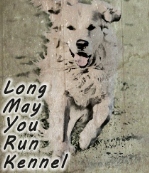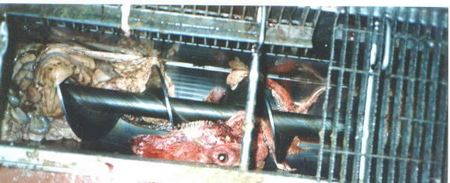The Shocking Truth About Commercial Dog Food
Warning! The following story is shocking… but true. It’s taken with permission from an article which appeared in the Earth Island Journal:
“The rendering plant floor is piled high with “raw product”… Thousands of dead dogs and cats; heads and hooves from cattle, sheep, pigs and horses; whole skunks; rats and raccoons… all waiting to be processed. In the ninety degree heat, the piles of dead animals seem to have a life of their own as millions of maggots swarm over the carcasses.
“Two bandanna-masked men begin operating Bobcat mini-dozers, loading the “raw” into a ten-foot deep stainless steel pit. They are undocumented workers from Mexico doing a dirty job. A giant auger at the bottom of the pit begins to turn. Popping bones and squeezing flesh are sounds from a nightmare you will never forget.
“Rendering is the process of cooking raw animal material to remove the moisture and fat. The rendering plant works like a giant kitchen. The cooker, or “chef”, blends the raw product in order to maintain a certain ratio between the carcasses of pets, livestock, poultry waste and supermarket rejects.
“Once the mass is cut into small pieces, it is transported to another auger for fine shredding. It is then cooked at 280 degrees for one hour. The continuous batch cooking process goes on non-stop, 24 hours a day, seven days a week as meat is melted away from bones in the hot “soup”. During this cooking process, the “soup” produces a fat of yellow grease or tallow that rises to the top and is skimmed off. The cooked meat and bone are sent to a hammer-mill press, which squeezes out the remaining moisture and pulverizes the product into a gritty powder. Shaker screens sift out excess hair and large bone chips. Once the batch is finished, all that is left is yellow grease, meat and bone meal.”
Welcome to the Dark Side of Recycling
So, what on earth could this unsavory concoction be legitimately used for?
Certainly not to make anything edible… right?
Unfortunately… as hard as it is to believe… the final “product” of this grisly process is sold as a source of protein and fat for making animal feeds.
That’s right… food ingredients to be fed to chickens, pigs, cattle… and you guessed it… dogs!
These revolting products are actually used to make dog food.
Every day, hundreds of rendering plants across America ship thousands of pounds of this recycled garbage to ranches, farms, feed lots… and pet food manufacturers.
Each batch of rendered product is labeled… according to its dominant animal source. That’s why on a dog food label you’ll see so many ingredients that look like these…
- Poultry by-product meal
- Meat by-product meal
- Fish meal
- Animal fat
All are products of the rendering process.
Toxic Waste and Euthanized Pets
But this same complex system which converts waste into animal feed has also evolved into a recycling nightmare. That’s because rendering plants are unavoidably processing toxic waste, too.
Here’s how…
The dead animals are frequently accompanied by a host of unwanted ingredients. Pesticides enter the rendering process via tainted livestock.
Fish oil is commonly contaminated with mercury and other heavy metals.
Dead pets are frequently thrown into the grinder with their flea collars still attached. Insecticide-laced patches found on the skin of slaughtered cattle are also carelessly added to the mix.
Antibiotics and other pharmaceuticals follow livestock directly into the soup. And drugs given to euthanize pets have been regularly found in the rendered product.
Unwanted metal contaminants can be traced to a variety of sources including pet collars, ID tags, surgical pins, and needles.
Even plastics end up getting into the process.
Finding a Use for Spoiled Grocery Meats
Every day, out-of-date supermarket meats as well as spoiled fish and poultry arrive by the truckload… right in their original Styrofoam trays and shrink wrap. There’s simply no time for the tedious task of unwrapping each individual package of the many thousands of rejected products.
Plastic cattle ID lags, pesticide patches and even the green waste disposal bags containing pets from veterinarians are tossed directly into the pit.
As you can see, literally all of it (plastic, paper, cardboard, and whatever) goes right into the rendering machine.
By now, you must be starting to figure it all out. Much of what goes into dog food is simply what’s left over after the processing of human food. It’s what’s commonly classified as “unfit for human consumption”.
Unfit for Humans… Legal for Dog Food
Here’s a short list of some of the unsavory raw materials I’ve already mentioned… plus a few others. All of the following ingredients are appalling… yet each can be lawfully used to make dog food:
- Slaughterhouse waste (organs, heads, hooves, beaks, feet)
- Bread and cereal rejects (cobs, stalks, mill sweepings)
- Contaminated grain middlings
- Dying, diseased and disabled farm animals
- Road kill (deer, skunks, and raccoons)
- Distiller fermentation waste
- Spoiled supermarket food
- Dead zoo animals
- Restaurant grease
- Euthanized cats and dogs
The pet food industry can be… at least in part… a sinister waste disposal vehicle for the human food manufacturers… and a way to profit from its own garbage. Many companies practice legal witchcraft by magically turning their trash… into cash.
My Strongest Recommendation
Learn to readily spot these “profit-first” dog food companies… and avoid buying their second-rate products.
Look for brands made by conscientious manufacturers who take great pride in producing top-tier products… products designed to significantly enhance… and extend your dog’s life.
Learn why you should be skeptical of dog food products that claim to be “premium”, “natural” or “gourmet”.

